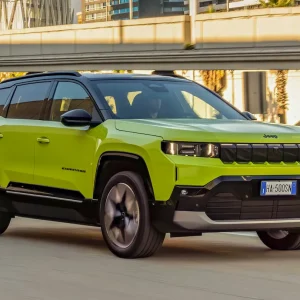Having famous relations is no guarantee of success. Take Posh Spice’s boy. Nice lad no doubt, but try as he might, he’s never going to bend it like Beckham.
Much the same can be said of the Polo GTI. Squint, and you’ll be hard pressed to tell it apart from the Golf GTI, thanks to those familiar sharp lines, bejewelled lighting stacks, scarlet detailing and prominent GTI addendum.
Even so, when it comes to driving, the two cars are simply gene pools apart.
It’s hard to fathom exactly why the differences are so stark, given Volkswagen almost invented the hot hatch genre and the Golf GTI’s enviable reputation is founded on the twin virtues of speedy thrills and everyday usability.
Not so the Polo.
Elephant in the room
Granted, it has a less sophisticated rear axle than the Golf but the real elephant in the room is the Polo’s suspension settings.
With about as much subtlety as a blacksmith’s handshake, the springs and dampers are so firm the rear axle lives in a constant state of frenzy. So much so, that if you select the even firmer sport mode, you’ll spend your whole life avoiding pot-holed high streets for fear of shaking your contact lenses loose.

It’s a similar story on the motorway, where the brittleness of the suspension transmits every grainy surface imperfection directly into the cabin.
OK, so firm goes hand in hand with tenacious grip and spirited handling, right? Well not exactly.
The Polo’s steering isn’t the last word in feel but it does build weight smoothly and progressively and there’s plenty of grip when you start pushing matters, – always providing you can find a series of smoothly surfaced bends.
There’s also very little in the way of body roll, but despite this, the front end of the car doesn’t change direction with the kind of immediacy that you might expect, let alone with the same tenacity as a Ford Fiesta ST.
Conversely, the rest of the controls are downright aggressive. With a razor-edged throttle take-up and an antagonistic brake application, you’ll need a balletic right foot to exact a smooth driving technique.
Electric performance
To be fair, the performance is pretty electric. Packing a detuned 200hp version of the Golf’s 2.0-litre four-cylinder engine, acceleration arrives hard and fast, as the rev counter needle fizzes towards the dizzy red line accompanied by a rushy turbo induction note.
If you’re not fazed by the heebie-jeebies ride quality, then there’s plenty to admire inside.
While the driving position is spot-on, with a generous amount of adjustment for the flat-bottomed steering wheel and tartan-clad driver’s seat, the cabin’s ambience is enhanced by large panes of glass, so things feel light and airy inside and all-round visibility is excellent.
There’s also lots of soft-touch plastics, colour-coordinated interior panels and a high-tech 8in infotainment touchscreen. It’s mounted high up in the middle of the dashboard, so the crystal-clear screen appears like an extension to the main instruments that lie behind the steering wheel.

Unlike many touchscreens, it’s intuitive to use and extremely quick-witted but, as with all touchscreens, it does quickly get covered in greasy finger marks, so it’s a good idea to keep a microfibre cloth handy to wipe away the smears.
Anyone expecting the Polo GTI to be a junior version of the Golf GTI will be sorely disappointed. Yes, it has many of the qualities that make its more expensive sibling such a desirable object. The interior is a delight, the performance is certainly more than adequate and the everyday practicality of the car is beyond reproach. Trouble is, the ride is so unforgiving and the controls are so aggressive you can only suspect VW’s normally wondrous engineers were on holiday the day the Polo GTI was signed off.





